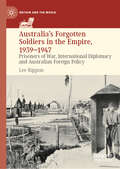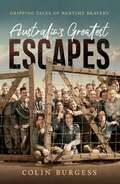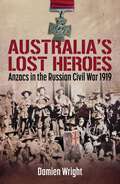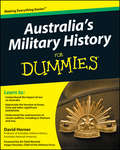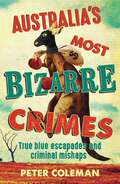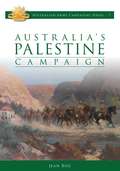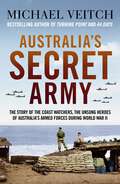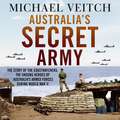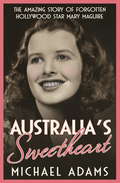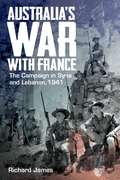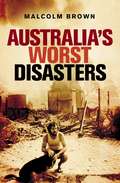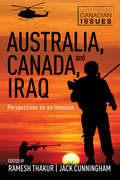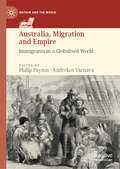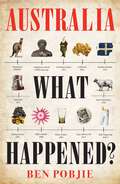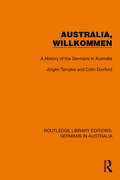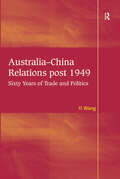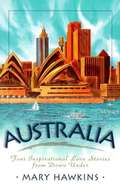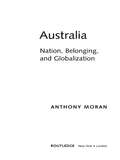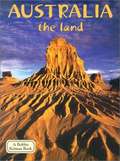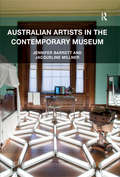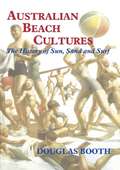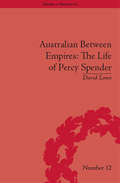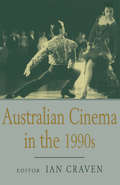- Table View
- List View
Australia's Forgotten Soldiers in the Empire, 1939–1947: Prisoners of War, International Diplomacy and Australian Foreign Policy (Britain and the World)
by Lee RipponThis book explores how Australia managed the prisoner of war issue throughout the Second World War and the immediate post-war period. It examines how the Australian government responded to the captivity of thousands of Australians in Italy and the detention of an even greater number of Italians in Australia. The war, it finds, created a series of diplomatic and political challenges for belligerent governments, including Australia. The author contends that Australia’s response was guided not only by other pragmatic considerations such as reciprocity, the practicalities of war and, importantly, national interest. The Australian government was not the only one to manage its prisoner of war policy in this way. By exploring the Australian government’s relationship with Britain as part of the British Empire, this book clarifies under what circumstances and to what extent Australia sought to assert a level of independence in pursuing its national interest, even when that approach did not align with British policy.
Australia's Greatest Escapes: Gripping tales of wartime bravery
by Colin BurgessAustralia's greatest escape stories from two world wars Australia&’s Greatest Escapes is a collection of stories about the most hazardous aspect of the prisoner of war experience – escape. Here is all the adventure, suspense and courage of ordinary Australians who defied their captors; men who tunnelled to freedom, crawled through stinking drains, or clawed a passage beneath barbed wire in a desperate attempt to flee captivity. They were willing to risk the odds and even death in the loneliest war of all – the fight to be free. Each possessed in spades the noble qualities of boldness, resourcefulness, cunning, determination and mateship we have come to admire about our Australian service men and women under adversity. Featuring stories of Australian POWs from all theatres of war, including one who fled a German work camp during World War I, another involved in a mass tunnel escape from a notorious Italian camp, and an airman who brazenly attempted to steal a German fighter and fly it back to England. We also re-live the tragic saga of the Sandakan death marches in which six Australian escapers became the only survivors from 2000 POWs, and follow the perilous journeys to freedom undertaken by Australian infantrymen following the appalling massacre of their fellow soldiers on the Japanese-held island of Ambon.
Australia's Lost Heroes: Anzacs in the Russian Civil War 1919
by Damien WrightThis extraordinary book is both an engaging military history and an enthralling mystery. Australia&’s Lost Heroes tells the astonishing little-known story of the Australian soldiers who fought the Red Army in Russia in 1919 and the personal odyssey, 100 years later, to locate and identify the lost grave of Victoria Cross hero Sergeant Samuel Pearse VC MM.The Anzac volunteers fought an arduous campaign punctuated by fierce ambushes in thick forest, swamps and marshes and attacks on fortified bunkers. They also had to fight a war within, avoiding the treachery and mutiny of White Russian &‘allies&’. Remarkably, two Australians were awarded the Victoria Cross, one posthumously. Yet, unlike the reverence, recognition and commemoration afforded to WWI soldiers, not only do the deeds of Anzacs in Russia remain unrecognized, their graves lie lost and forgotten. Follow the author&’s journey to a remote corner of Russia with the grandson of Samuel Pearse in the hope of identifying the lost grave. Guided by a Russian battlefield archaeologist, they discover an astonishing clue which may resolve the mystery of an Australian hero missing for 100 years. An extraordinary story of national importance dedicated to those forgotten Australian heroes who fought and died in Russia after the Armistice.
Australia's Military History For Dummies (For Dummies Ser.)
by David HornerCreated especially for the Australian customer! The simple and easy way to get your mind around Australia's military history More people are visiting Gallipoli and walking the Kokoda Trail each year — now find out why. This complete guide helps you trace the story of Australia's involvement in war, from the colonial conflicts with the Indigenous population, through the World Wars to peacekeeping initiatives in East Timor and the controversial conflict in Afghanistan. Find out the origins of Australia's military history — go all the way back to the arrival of the First Fleet and the conflicts with the Indigenous peoples Learn about the heroism of the Anzacs — discover the origins of the legend of Gallipoli, and how the brass bungled the campaign Discover the horrors of war — consider the suffering and huge losses on the Western Front Recognise the successful battles of World Wars I and II — follow the Diggers' exploits in Palestine and Syria, and at Tobruk and Alamein Marvel at the grim jungle battles — track the Diggersthrough New Guinea, Borneo, Malaya and Vietnam between 1942 and 1972 Admire Australia's efforts to repel possible invaders — learn how Australians defended their country against the Japanese during World War II See how the Cold War heated up — witness the fight against communism in the Korean and Vietnam Wars Appreciate the modern-day Australian Defence Force — acknowledge the courage of the men and women who protectus into the 21st century Open the book and find: New insights into the meaning of Anzac Day Simple explanations of the structure of Australia's military Details of who fought whom, where, when and why Stories of Australia's great military fighters and leaders Accounts of the iconic battles that established Australia's reputation Locations of Australia's peacekeeping operations around the world Ways in which war and conflict have shaped the nation Reasons why Australia goes to war Learn to: Comprehend the impact of waron Australia Appreciate the heroism at AnzacCove and other significant battlefields Understand the controversies ofrecent conflicts, including in Vietnam and Iraq
Australia's Most Bizarre Crimes
by Peter ColemanTrue tales of crimes so bizarre you might not believe them.The mysterious disappearance of thousands of false teeth, international travel via the postal system, doughnut delivery heists, clowns terrorising a neighbourhood, the theft of a three-storey-high replica mango, criminal clairvoyants making off with haunted cash: could crime get any weirder, and could people get any stupider?In Australia's Most Bizarre Crimes, Peter Coleman explores the archives and recent records to produce this astounding collection of criminal mishaps that will have you laughing even as you shake your head in disbelief.
Australia's Most Bizarre Crimes
by Peter ColemanTrue tales of crimes so bizarre you might not believe them.The mysterious disappearance of thousands of false teeth, international travel via the postal system, doughnut delivery heists, clowns terrorising a neighbourhood, the theft of a three-storey-high replica mango, criminal clairvoyants making off with haunted cash: could crime get any weirder, and could people get any stupider?In Australia's Most Bizarre Crimes, Peter Coleman explores the archives and recent records to produce this astounding collection of criminal mishaps that will have you laughing even as you shake your head in disbelief.
Australia's Palestine Campaign 1916-1918 (Australian Army Campaigns Series #7)
by Jean BouWith nearly two mounted divisions engaged against the Ottoman Empire in the Middle East for almost three years the Palestine Campaign was Australia's longest running militarily significant endeavour of the First World War after the Western Front. And yet apart from the battle of Beersheba, the Palestine Campaign receives little attention in Australia compared to Gallipoli and the Western Front. In contrast to the years of grinding trench warfare in France and Belgium, the Palestine Campaign was a war of relative movement and manoeuvre. Cavalry, including Australia's light horse, played a prominent role, but it was a hard fought fully modern war, in which the latest military technologies and techniques were all used.
Australia's Secret Army
by Michael VeitchEstablished after World War I by the Royal Australian Navy, the Coast Watchers were a loose organisation of several hundred European settlers, missionaries, patrol officers and planters living in British and Australian Pacific Island territories whose job it was to observe and report on the enemy. They were mostly all unpaid volunteers whose job it was simply to observe and report on foreign shipping and aeroplane movements. It was never envisaged that the Coast Watchers would do any fighting, nor operate inside enemy-occupied territory. But when World War II came to the Pacific, that is exactly what they ended up doing, becoming, in effect, Australia's secret army. Fully cognisant of their fate should they be caught, they nonetheless battled not just the enemy, but constant exhaustion, tropical disease, and the ever-present spectre of capture, torture and death.Without the Coast Watchers and the crucial intelligence they provided, key moments in the war could have turned out very differently. This is the story of these unsung heroes who risked their lives - and sometimes lost them - in the service of their country.
Australia's Secret Army
by Michael VeitchEstablished after World War I by the Royal Australian Navy, the Coast Watchers were a loose organisation of several hundred European settlers, missionaries, patrol officers and planters living in British and Australian Pacific Island territories whose job it was to observe and report on the enemy. They were mostly all unpaid volunteers whose job it was simply to observe and report on foreign shipping and aeroplane movements. It was never envisaged that the Coast Watchers would do any fighting, nor operate inside enemy-occupied territory. But when World War II came to the Pacific, that is exactly what they ended up doing, becoming, in effect, Australia's secret army. Fully cognisant of their fate should they be caught, they nonetheless battled not just the enemy, but constant exhaustion, tropical disease, and the ever-present spectre of capture, torture and death.Without the Coast Watchers and the crucial intelligence they provided, key moments in the war could have turned out very differently. This is the story of these unsung heroes who risked their lives - and sometimes lost them - in the service of their country.
Australia's Sweetheart: The amazing story of forgotten Hollywood star Mary Maguire
by Michael AdamsThis is the fascinating story of Mary Maguire, a 1930s Australian ingenue who sailed for Hollywood and a fabulous life, only to have her career cut short by scandal and tragedy. Packed with celebrity, history and gossip, AUSTRALIA'S SWEETHEART is perfect for readers of SHEILA and THE RIVIERA SET.Mary Maguire was Australia's first teenage movie star and she captivated Hollywood in the mid 1930s. Mary lived on three continents and was celebrated in Melbourne, Brisbane, Sydney, Los Angeles and London. Her life was lived in parallel with seminal incidents of the twentieth century: the Spanish Flu; the Great Depression; the Bodyline series; Australia's early radio, talkies and aviation; Hollywood's Golden Era; the British aristocracy's embrace of European fascism; London's Blitz; and post-war American culture and politics. Mary knew everyone, from Douglas Jardine, Don Bradman, Errol Flynn and Ronald Reagan, to William Randolph Hearst, Maureen O'Sullivan, Judy Garland and Queen Elizabeth II.AUSTRALIA'S SWEETHEART in an irresistible never-before-told story that captures the glamour of Hollywood and the turbulent times of the twentieth century, with a young woman at its centre. If you loved THE AMAZING MRS LIVESEY, Robert Wainwright's SHEILA and MISS MURIEL MATTERS, you will adore AUSTRALIA'S SWEETHEART.
Australia's War with France: The Campaign in Syria and Lebanon, 1941
by Richard James1941: Great Britain is fighting for its very existence. France has surrendered and installed Marshal Pétain, an ageing reactionary, as head of a hostile new government at Vichy. The Allied outpost in Egypt, and the Suez Canal—its strategic jewel—are threatened on both sizes. To the west, Rommel is rampaging through North Africa. To the east, the Germans are arming rebels and fostering an uprising in British Iraq. Churchill&’s cabinet is reeling after disastrous campaign in Greece. There are fears of a German takeover in Vichy-controlled Syria and Lebanon, where a languishing French colonial army may fall in line with the Nazis. Churchill orders a disgruntled General Wavell to take the offensive, assuming that the French will not put up a fight against an Allied show of force. The only troops available are a division of Australians, the 7th: untested recruits, digging ditches in the Egyptian desert. This is the story of how the 7th Division came to fight against the Army of the Levant—Australia against France—in the rocky hills of Lebanon and the barren wastes of Syria. Contrary to Churchill&’s expectations, the French resisted viciously. The Australians won the war, but at the price of more than 400 young men, sons of Anzacs who had fought to defend France in the trenches of the western Front. The British were embarrassed, the campaign was forgotten, and the Australians who fought were dubbed &‘the silent men.&’ No contemporary Australian historian has studied the conflict. British and French accounts exist, but fail to do justice to the Australian contribution. Through interviews with the veterans, archival records, and on-the-ground research, this book seeks to understand a neglected campaign and give it a proper place in Australian history.
Australia's Worst Disasters
by Malcolm BrownGraphic accounts of Australia?s worst disasters ? historical as well as events of recent years.From the Ash Wednesday bushfires of 1983 to the implosion of the Royal Canberra Hospital in 1997, and from the shocking Granville railway crash in 1977 to the Sea King helicopter crash of 2005, Australia's history has been punctuated by incidents of disaster and tragedy that have shocked us all. Sometimes warning signs were not read (or were ignored); sometimes human error was to blame. These graphic and compelling accounts by veteran Sydney Morning Herald journalist Malcolm Brown and other award-winning journalists tell us far more than simply what happened - they provide unique insights into the impact of these events on the lives of innocent people. And, interspersed with stories of death and destruction, are heart-warming accounts of courage, grace and just plain good luck.
Australia, Canada, and Iraq: Perspectives on an Invasion
by Ramesh Thakur Jack CunninghamA collection of essays on the war in Iraq; including pieces by Jean Chrétien and John Howard, the prime ministers during the war. When it was declared in 2003, the U.S.-led invasion of Iraq was intensely controversial. While a few of America's partners, like Australia, joined in the war, many, including Canada, refused to take part. However the war in Iraq was viewed at the time, though, it is clear that that war and the war in Afghanistan have had a profound and lasting impact on international relations. Australia, Canada, and Iraq collects essays by fifteen esteemed academics, officials, and politicians, including the prime ministers of Australia and Canada at the time of the war — John Howard and Jean Chretién, respectively. This volume takes advantage of the perspective offered by the decade since the war to provide a clearer understanding of the Australian and Canadian decisions regarding Iraq, and indeed of the invasion itself.
Australia, Migration and Empire: Immigrants in a Globalised World (Britain and the World)
by Andrekos Varnava Philip PaytonThis edited collection explores how migrants played a major role in the creation and settlement of the British Empire, by focusing on a series of Australian case studies. Despite their shared experiences of migration and settlement, migrants nonetheless often exhibited distinctive cultural identities, which could be deployed for advantage. Migration established global mobility as a defining feature of the Empire. Ethnicity, class and gender were often powerful determinants of migrant attitudes and behaviour. This volume addresses these considerations, illuminating the complexity and diversity of the British Empire’s global immigration story. Since 1788, the propensity of the populations of Britain and Ireland to immigrate to Australia varied widely, but what this volume highlights is their remarkable diversity in character and impact. The book also presents the opportunities that existed for other immigrant groups to demonstrate their loyalty as members of the (white) Australian community, along with notable exceptions which demonstrated the limits of this inclusivity.
Australia, What Happened?
by Ben PobjieWhen our politicians are too busy playing musical chairs to run the country, our cricketers are doing suspicious things with sandpaper, and a murderous starfish with twenty-one arms roams freely around the Great Barrier Reef it seems about time that we, as a nation, ask a tough question: how the heck did it come to this?In Australia - What Happened? TV columnist, comedian and history buff Ben Pobjie turns an incredulous eye on the history of Australia to bust open the national mythology, reveal the truth about what it means to be an Australian and work out what happened to all our best-laid plans.What's the real story of the Aussie larrikin? How exactly did sheep ruin everything? What impact did the Gold Rush have on Australian culture? And what do you mean 'murderous starfish'? All these questions and more will be answered in this hilarious and historically accurate account of our wayward nation.
Australia, Wilkommen: A History of the Germans in Australia (Routledge Library Editions: Germans in Australia #1)
by Jürgen Tampke Colin DoxfordAustralia, Wilkommen (1990) documents the rich and varying contribution made by Germans in Australia. Originally welcomed as hardy pioneers, German settlers were responsible for discovering and opening up vast tracts of land. German scientists and entrepreneurs played a large role in the Australian economy. But as the German empire expanded into the Pacific, and Britain and Australia were drawn into two world wars, perceptions of Germany and its people changed and immigrants were caught in the crossfire between the old and new worlds. This book examines these issues surrounding German immigration into Australia, and the shifting perceptions of both the immigrants and the nation itself.
Australia-China Relations post 1949: Sixty Years of Trade and Politics
by Yi WangThis book challenges the common perceptions of Australian dependence upon great-power allies in the conduct of its foreign relations through a critical examination of Australia's relations with the People's Republic of China. The author focuses on the economic and political dimensions of the policy-making process from the founding of the PRC in 1949 to the present era, against an analytical framework that takes into account both internal and external factors in the formulation and implementation of Australian foreign policy. Informed by political science and international relations, the book differs from the conventional literature on Sino-Australian relations, which has either focused on pure economic analysis or concentrated on chronicling historical events. The author weaves theoretical insights from political science and international relations into the historical analysis while seeking to examine the interplay between political and economic factors over time in shaping policy outcomes. The book draws not only on primary and secondary sources but also on information and insights obtained from interviews with a vast array of direct participants in the policy process, including almost all the former ambassadors from both China and Australia, covering the entire period of the diplomatic relationship. As a result, the book breaks new ground, especially from the Hawke era onwards, revealing hitherto overlooked details of interest in the policy process.
Australia: Four Inspirational Love Stories from the Land Down Under
by Mary HawkinsGo down under with a contemporary collection of four complete novels and one novella. Starting in Search for Tomorrow, readers will follow Gail as she rebuilds her life after a tragedy takes the ones she loves. In Search for Yesterday, they will sympathize with Hilda when she learns she has a father she never knew and strength that had never been tested before. They will root for Beth and Art when they attempt to rebuild a broken body and marriage in Search for Today. Then, in the novella, Search for the Star, the readers will explore Jean's second chance with an old love.
Australia: Nation, Belonging, and Globalization (Global Realities #Vol. 1)
by Anthony MoranIn this book Anthony Moran traces the development of contemporary Australian society in the global age, focusing on four major themes: settler/indigenous relations; economics and culture since the 1980s and their impact on national identity; the effects of increasing diversity fostered by globalization; and the transformation of Australian social space wrought by globalization.
Australia: The Land (Lands, Peoples, and Cultures)
by Erinn BantingEarth did not always look as it does today. Hundreds of millions of years ago, it was covered by one enormous landmass called Pangaea. About 200 million years ago, Pangaea began to split in two. Slowly, the two pieces drifted farther apart and split into even more pieces. Eventually, the seven continents formed: North America, South America, Europe, Asia, Africa, Australia, and Antarctica. Australia and Antarctica drifted the farthest south, into the southern hemisphere.
Australian Artists in the Contemporary Museum
by Jennifer Barrett Jacqueline MillnerThis unique book proposes a re-reading of the relationship between artists and the contemporary museum. In Australia in particular, the museum has played a significant role in the colonial project and this has generally been considered as the predominant mode of artists' engagement with such institutions and collections. Australian Artists in the Contemporary Museum expands the post-colonial frame of reference used to interpret this work, to demonstrate the broader implications of the relationship between artists and the museum, and thus to offer an alternative way of understanding recent contemporary practices. The authors' central argument is that artists' engagement with the museum has shifted from politically motivated critique taking place in museums of fine art, towards interventions taking place in non-art museums that focus on the creation of knowledge more broadly. Such interventions assume a number of forms, including the artist acting as curator, art works that highlight the use of taxonomic modes of display and categorization, and the re-consideration of the aesthetics of collections to suggest different ways of interpreting objects and their history. Central to these interventions is the challenge to better connect the museum and its public. The book will be essential reading for scholars, professionals and students in the fields of contemporary art and museum studies, art history, and in the museum sector. These include artists, curators, museum and gallery professionals, postgraduate researchers, art historians, designers and design scholars, art and museum educators, and students of visual art, art history, and museum studies. This project has been assisted by the Australian government through the Australia Council for the Arts, its arts funding and advisory body.
Australian Battalion Commanders In The Second World War
by Garth PrattenThis book explores the background, role and conduct of the commanding officers of Australian infantry battalions in World War II.
Australian Beach Cultures: The History of Sun, Sand and Surf (Sport in the Global Society #No. 28)
by Douglas BoothAustralians are surrounded by beaches. But this enclosure is more than a geographical fact for the inhabitants of an island continent; the beach is an integral part of the cultural envelope. This work analyzes the history of the beach as an integral aspect of Australian culture.
Australian Between Empires: The Life Of Percy Spender (Empires in Perspective #12)
by David LowePart biography, part transnational history, this study details the life and career of Percy Spender, one of Australia's most prominent twentieth-century political figures.
Australian Cinema in the 1990s
by Ian CravenThis study is a collection of critical and scholarly analyses of the organisation of the Australian Film Industry since 1990. Particular emphasis is put on globalisation, authorship, national narrative and film aesthetics.
